
Illustrative Math Alignment: Grade 8 Unit 3
Linear Relationships
Lesson 10: Calculating Slope
Use the following Media4Math resources with this Illustrative Math lesson.
| Thumbnail Image | Title | Body | Curriculum Topic |
|---|---|---|---|

|
Lesson Plan--Slope Concepts--Lesson 1--What Is Slope? | Lesson Plan: What Is Slope? This lesson is the first in a six-part series designed to introduce middle school students to the concept of slope. Through interactive digital resources from Media4Math, students will explore how slope represents the ratio of vertical change to horizontal change between two points on a line. Key learning objectives include: Defining slope as a ratio of rise over run.Interpreting slope in real-world scenarios, such as staircases and ramps.Calculating slope using coordinate points on a graph.The lesson includes engaging digital media, practice problems, and guided activities to help students develop a strong conceptual understanding. This resource is aligned with educational standards, making it an essential part of any middle school math curriculum. Subscribers to Media4Math can download PDF versions of the lesson plan for easy classroom use. |
Slope |

|
Lesson Plan--Slope Concepts--Lesson 2--Slope and Similar Triangles | Lesson Plan: Slope and Similar Triangles This lesson is the second installment in Media4Math's comprehensive six-part series on understanding slope in mathematics. It explores the relationship between slope and similar triangles, providing students with a geometric perspective on why the slope between any two distinct points on a non-vertical line remains constant. |
Slope |

|
Lesson Plan--Slope Concepts--Lesson 3--Visualizing Slope | Lesson Plan: Visualizing Slope on a Graph This lesson is the third installment in Media4Math's comprehensive six-part series on understanding slope in mathematics. It focuses on helping students visualize and comprehend slope by engaging in hands-on activities that involve plotting points on a coordinate plane and analyzing the resulting lines. |
Slope |

|
Lesson Plan--Slope Concepts--Lesson 4--Types of Slope | Lesson Plan: Types of Slope This lesson is the fourth installment in Media4Math's comprehensive six-part series on understanding slope in mathematics. It focuses on helping students differentiate among the four types of slope: positive, negative, zero, and undefined. Through interactive activities and visual aids, students will analyze how each type of slope affects the direction of a line on a graph. |
Slope |

|
Lesson Plan--Slope Concepts--Lesson 5--The Slope Formula | Lesson Plan: The Slope Formula This lesson is the fifth installment in Media4Math's comprehensive six-part series on understanding slope in mathematics. It introduces students to the slope formula, a fundamental tool in algebra for determining the steepness and direction of a line between two points on a coordinate plane. |
Slope |
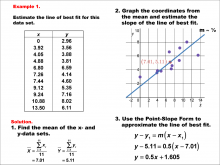
|
Math Example--Charts, Graphs, and Plots--Estimating the Line of Best Fit: Example 1 | Math Example--Charts, Graphs, and Plots-- Estimating the Line of Best Fit: Example 1
In this set of math examples, analyze the behavior of different scatterplots. This includes linear and quadratic models. |
Slope-Intercept Form and Data Analysis |

|
Math Example--Charts, Graphs, and Plots--Estimating the Line of Best Fit: Example 1 | Math Example--Charts, Graphs, and Plots-- Estimating the Line of Best Fit: Example 1
In this set of math examples, analyze the behavior of different scatterplots. This includes linear and quadratic models. |
Slope-Intercept Form and Data Analysis |
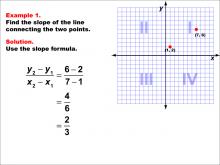
|
Math Example--Coordinate Geometry--Slope Formula: Example 1 | Math Example--Coordinate Geometry--Slope Formula: Example 1TopicSlope Formula DescriptionThis example demonstrates how to calculate the slope of a line connecting two points on a coordinate grid. The points (1, 2) and (7, 6) are plotted, and the slope formula is applied to find the slope between them. The calculation shows that the slope is (6 - 2) / (7 - 1) = 4 / 6 = 2 / 3. The slope formula is a fundamental concept in coordinate geometry, allowing us to determine the steepness and direction of a line. It's essential for understanding linear relationships and is widely used in various mathematical and real-world applications. |
Slope |

|
Math Example--Coordinate Geometry--Slope Formula: Example 1 | Math Example--Coordinate Geometry--Slope Formula: Example 1TopicSlope Formula DescriptionThis example demonstrates how to calculate the slope of a line connecting two points on a coordinate grid. The points (1, 2) and (7, 6) are plotted, and the slope formula is applied to find the slope between them. The calculation shows that the slope is (6 - 2) / (7 - 1) = 4 / 6 = 2 / 3. The slope formula is a fundamental concept in coordinate geometry, allowing us to determine the steepness and direction of a line. It's essential for understanding linear relationships and is widely used in various mathematical and real-world applications. |
Slope |
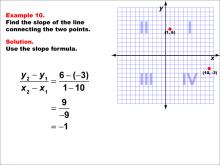
|
Math Example--Coordinate Geometry--Slope Formula: Example 10 | Math Example--Coordinate Geometry--Slope Formula: Example 10TopicSlope Formula DescriptionThis example illustrates the calculation of slope for a line connecting two points: (1, 6) and (10, -3) on a Cartesian plane. Applying the slope formula, we find that the slope is (6 - (-3)) / (1 - 10) = 9 / -9 = -1. The slope formula is a crucial concept in coordinate geometry, helping us understand the steepness and direction of lines. This example demonstrates how to handle points with both positive and negative coordinates when calculating slope, resulting in a negative slope. |
Slope |

|
Math Example--Coordinate Geometry--Slope Formula: Example 10 | Math Example--Coordinate Geometry--Slope Formula: Example 10TopicSlope Formula DescriptionThis example illustrates the calculation of slope for a line connecting two points: (1, 6) and (10, -3) on a Cartesian plane. Applying the slope formula, we find that the slope is (6 - (-3)) / (1 - 10) = 9 / -9 = -1. The slope formula is a crucial concept in coordinate geometry, helping us understand the steepness and direction of lines. This example demonstrates how to handle points with both positive and negative coordinates when calculating slope, resulting in a negative slope. |
Slope |
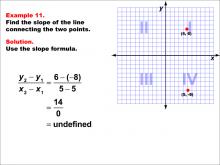
|
Math Example--Coordinate Geometry--Slope Formula: Example 11 | Math Example--Coordinate Geometry--Slope Formula: Example 11TopicSlope Formula DescriptionThis example demonstrates the calculation of slope for a vertical line connecting points (5, 6) and (5, -8) on a Cartesian plane. When we apply the slope formula, we find that the slope is (6 - (-8)) / (5 - 5) = 14 / 0, which is undefined. The slope formula is a key concept in coordinate geometry, helping us understand the steepness and direction of lines. This particular example highlights a special case where the line is vertical, resulting in an undefined slope. |
Slope |

|
Math Example--Coordinate Geometry--Slope Formula: Example 11 | Math Example--Coordinate Geometry--Slope Formula: Example 11TopicSlope Formula DescriptionThis example demonstrates the calculation of slope for a vertical line connecting points (5, 6) and (5, -8) on a Cartesian plane. When we apply the slope formula, we find that the slope is (6 - (-8)) / (5 - 5) = 14 / 0, which is undefined. The slope formula is a key concept in coordinate geometry, helping us understand the steepness and direction of lines. This particular example highlights a special case where the line is vertical, resulting in an undefined slope. |
Slope |
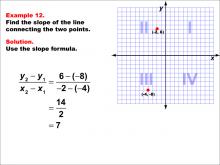
|
Math Example--Coordinate Geometry--Slope Formula: Example 12 | Math Example--Coordinate Geometry--Slope Formula: Example 12TopicSlope Formula DescriptionThis example illustrates the calculation of slope for a line connecting two points: (-2, 6) and (-4, -8) on a Cartesian plane. Applying the slope formula, we find that the slope is (6 - (-8)) / (-2 - (-4)) = 14 / 2 = 7. The slope formula is a fundamental concept in coordinate geometry, helping us understand the steepness and direction of lines. This example demonstrates how to handle points with negative coordinates when calculating slope, resulting in a positive slope. |
Slope |

|
Math Example--Coordinate Geometry--Slope Formula: Example 12 | Math Example--Coordinate Geometry--Slope Formula: Example 12TopicSlope Formula DescriptionThis example illustrates the calculation of slope for a line connecting two points: (-2, 6) and (-4, -8) on a Cartesian plane. Applying the slope formula, we find that the slope is (6 - (-8)) / (-2 - (-4)) = 14 / 2 = 7. The slope formula is a fundamental concept in coordinate geometry, helping us understand the steepness and direction of lines. This example demonstrates how to handle points with negative coordinates when calculating slope, resulting in a positive slope. |
Slope |
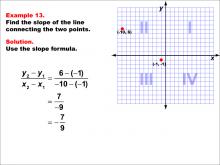
|
Math Example--Coordinate Geometry--Slope Formula: Example 13 | Math Example--Coordinate Geometry--Slope Formula: Example 13TopicSlope Formula DescriptionThis example demonstrates the calculation of slope for a line connecting two points: (-10, 6) and (-1, -1) on a Cartesian plane. The line crosses quadrants II and III. Applying the slope formula, we find that the slope is (6 - (-1)) / (-10 - (-1)) = 7 / -9 = -7 / 9. The slope formula is a crucial concept in coordinate geometry, helping us understand the steepness and direction of lines. This example shows how to handle points in different quadrants and with negative coordinates when calculating slope. |
Slope |

|
Math Example--Coordinate Geometry--Slope Formula: Example 13 | Math Example--Coordinate Geometry--Slope Formula: Example 13TopicSlope Formula DescriptionThis example demonstrates the calculation of slope for a line connecting two points: (-10, 6) and (-1, -1) on a Cartesian plane. The line crosses quadrants II and III. Applying the slope formula, we find that the slope is (6 - (-1)) / (-10 - (-1)) = 7 / -9 = -7 / 9. The slope formula is a crucial concept in coordinate geometry, helping us understand the steepness and direction of lines. This example shows how to handle points in different quadrants and with negative coordinates when calculating slope. |
Slope |
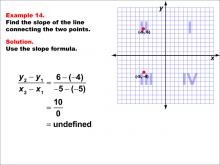
|
Math Example--Coordinate Geometry--Slope Formula: Example 14 | Math Example--Coordinate Geometry--Slope Formula: Example 14TopicSlope Formula DescriptionThis example illustrates the calculation of slope for a vertical line passing through two points: (-5, 6) and (-5, -4) in Quadrant II of a Cartesian plane. When we apply the slope formula, we find that the slope is (6 - (-4)) / (-5 - (-5)) = 10 / 0, which is undefined. The slope formula is a key concept in coordinate geometry, helping us understand the steepness and direction of lines. This particular example highlights a special case where the line is vertical, resulting in an undefined slope. |
Slope |

|
Math Example--Coordinate Geometry--Slope Formula: Example 14 | Math Example--Coordinate Geometry--Slope Formula: Example 14TopicSlope Formula DescriptionThis example illustrates the calculation of slope for a vertical line passing through two points: (-5, 6) and (-5, -4) in Quadrant II of a Cartesian plane. When we apply the slope formula, we find that the slope is (6 - (-4)) / (-5 - (-5)) = 10 / 0, which is undefined. The slope formula is a key concept in coordinate geometry, helping us understand the steepness and direction of lines. This particular example highlights a special case where the line is vertical, resulting in an undefined slope. |
Slope |
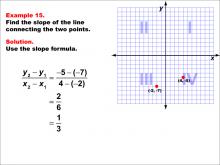
|
Math Example--Coordinate Geometry--Slope Formula: Example 15 | Math Example--Coordinate Geometry--Slope Formula: Example 15TopicSlope Formula DescriptionThis example demonstrates the calculation of slope for a line connecting two points: (4, -5) and (-2, -7) on a Cartesian plane. The line crosses quadrants III and IV. Applying the slope formula, we find that the slope is (-5 - (-7)) / (4 - (-2)) = 2 / 6 = 1 / 3. The slope formula is a fundamental concept in coordinate geometry, helping us understand the steepness and direction of lines. This example shows how to handle points with negative coordinates and in different quadrants when calculating slope. |
Slope |

|
Math Example--Coordinate Geometry--Slope Formula: Example 15 | Math Example--Coordinate Geometry--Slope Formula: Example 15TopicSlope Formula DescriptionThis example demonstrates the calculation of slope for a line connecting two points: (4, -5) and (-2, -7) on a Cartesian plane. The line crosses quadrants III and IV. Applying the slope formula, we find that the slope is (-5 - (-7)) / (4 - (-2)) = 2 / 6 = 1 / 3. The slope formula is a fundamental concept in coordinate geometry, helping us understand the steepness and direction of lines. This example shows how to handle points with negative coordinates and in different quadrants when calculating slope. |
Slope |

|
Math Example--Coordinate Geometry--Slope Formula: Example 16 | Math Example--Coordinate Geometry--Slope Formula: Example 16TopicSlope Formula DescriptionThis example demonstrates the calculation of slope for a line connecting two points: (9, -10) and (-1, -2) on a Cartesian plane. The line crosses quadrants III and IV diagonally. Applying the slope formula, we find that the slope is (-2 - (-10)) / (-1 - 9) = 8 / -10 = -4 / 5. The slope formula is a fundamental concept in coordinate geometry, helping us understand the steepness and direction of lines. This example shows how to handle points with both positive and negative coordinates when calculating slope, resulting in a negative fraction. |
Slope |

|
Math Example--Coordinate Geometry--Slope Formula: Example 16 | Math Example--Coordinate Geometry--Slope Formula: Example 16TopicSlope Formula DescriptionThis example demonstrates the calculation of slope for a line connecting two points: (9, -10) and (-1, -2) on a Cartesian plane. The line crosses quadrants III and IV diagonally. Applying the slope formula, we find that the slope is (-2 - (-10)) / (-1 - 9) = 8 / -10 = -4 / 5. The slope formula is a fundamental concept in coordinate geometry, helping us understand the steepness and direction of lines. This example shows how to handle points with both positive and negative coordinates when calculating slope, resulting in a negative fraction. |
Slope |

|
Math Example--Coordinate Geometry--Slope Formula: Example 17 | Math Example--Coordinate Geometry--Slope Formula: Example 17TopicSlope Formula DescriptionThis example illustrates the calculation of slope for a horizontal line connecting points (-2, -7) and (3, -7) on a Cartesian plane. When we apply the slope formula, we find that the slope is (-7 - (-7)) / (-2 - 3) = 0 / -5 = 0. The slope formula is a key concept in coordinate geometry, helping us understand the steepness and direction of lines. This particular example highlights a special case where the line is horizontal, resulting in a slope of zero, even when the points have different x-coordinates. |
Slope |

|
Math Example--Coordinate Geometry--Slope Formula: Example 17 | Math Example--Coordinate Geometry--Slope Formula: Example 17TopicSlope Formula DescriptionThis example illustrates the calculation of slope for a horizontal line connecting points (-2, -7) and (3, -7) on a Cartesian plane. When we apply the slope formula, we find that the slope is (-7 - (-7)) / (-2 - 3) = 0 / -5 = 0. The slope formula is a key concept in coordinate geometry, helping us understand the steepness and direction of lines. This particular example highlights a special case where the line is horizontal, resulting in a slope of zero, even when the points have different x-coordinates. |
Slope |
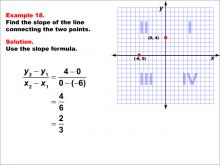
|
Math Example--Coordinate Geometry--Slope Formula: Example 18 | Math Example--Coordinate Geometry--Slope Formula: Example 18TopicSlope Formula DescriptionThis example demonstrates the calculation of slope for a line connecting two points: (-6, 0) and (0, 4) on a Cartesian plane. Applying the slope formula, we find that the slope is (4 - 0) / (0 - (-6)) = 4 / 6 = 2 / 3. The slope formula is a fundamental concept in coordinate geometry, helping us understand the steepness and direction of lines. This example shows how to handle points with both positive and negative coordinates when calculating slope, resulting in a positive fraction. |
Slope |

|
Math Example--Coordinate Geometry--Slope Formula: Example 18 | Math Example--Coordinate Geometry--Slope Formula: Example 18TopicSlope Formula DescriptionThis example demonstrates the calculation of slope for a line connecting two points: (-6, 0) and (0, 4) on a Cartesian plane. Applying the slope formula, we find that the slope is (4 - 0) / (0 - (-6)) = 4 / 6 = 2 / 3. The slope formula is a fundamental concept in coordinate geometry, helping us understand the steepness and direction of lines. This example shows how to handle points with both positive and negative coordinates when calculating slope, resulting in a positive fraction. |
Slope |
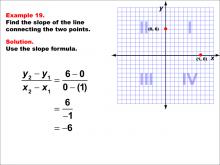
|
Math Example--Coordinate Geometry--Slope Formula: Example 19 | Math Example--Coordinate Geometry--Slope Formula: Example 19TopicSlope Formula DescriptionThis example illustrates the calculation of slope for a line connecting two points: (1, 0) and (0, 6) on a Cartesian plane. Applying the slope formula, we find that the slope is (6 - 0) / (0 - 1) = 6 / -1 = -6. The slope formula is a crucial concept in coordinate geometry, helping us understand the steepness and direction of lines. This example demonstrates how to handle points with both positive and negative coordinates when calculating slope, resulting in a negative integer slope. |
Slope |

|
Math Example--Coordinate Geometry--Slope Formula: Example 19 | Math Example--Coordinate Geometry--Slope Formula: Example 19TopicSlope Formula DescriptionThis example illustrates the calculation of slope for a line connecting two points: (1, 0) and (0, 6) on a Cartesian plane. Applying the slope formula, we find that the slope is (6 - 0) / (0 - 1) = 6 / -1 = -6. The slope formula is a crucial concept in coordinate geometry, helping us understand the steepness and direction of lines. This example demonstrates how to handle points with both positive and negative coordinates when calculating slope, resulting in a negative integer slope. |
Slope |
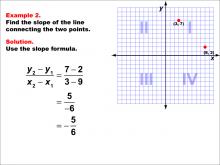
|
Math Example--Coordinate Geometry--Slope Formula: Example 2 | Math Example--Coordinate Geometry--Slope Formula: Example 2TopicSlope Formula DescriptionThis example illustrates the calculation of slope between two points (3, 7) and (9, 2) on a coordinate grid. The slope formula is applied to find that the slope is (7 - 2) / (3 - 9) = 5 / -6 = -5 / 6. Understanding the slope formula is crucial in coordinate geometry as it helps describe the steepness and direction of a line. This concept is widely used in various mathematical applications and real-world scenarios. |
Slope |

|
Math Example--Coordinate Geometry--Slope Formula: Example 2 | Math Example--Coordinate Geometry--Slope Formula: Example 2TopicSlope Formula DescriptionThis example illustrates the calculation of slope between two points (3, 7) and (9, 2) on a coordinate grid. The slope formula is applied to find that the slope is (7 - 2) / (3 - 9) = 5 / -6 = -5 / 6. Understanding the slope formula is crucial in coordinate geometry as it helps describe the steepness and direction of a line. This concept is widely used in various mathematical applications and real-world scenarios. |
Slope |
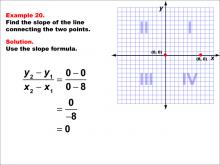
|
Math Example--Coordinate Geometry--Slope Formula: Example 20 | Math Example--Coordinate Geometry--Slope Formula: Example 20TopicSlope Formula DescriptionThis example demonstrates the calculation of slope for a horizontal line connecting points (0, 0) and (8, 0) on a Cartesian plane. When we apply the slope formula, we find that the slope is (0 - 0) / (8 - 0) = 0 / 8 = 0. The slope formula is a key concept in coordinate geometry, helping us understand the steepness and direction of lines. This particular example highlights a special case where the line is horizontal and lies on the x-axis, resulting in a slope of zero. |
Slope |

|
Math Example--Coordinate Geometry--Slope Formula: Example 20 | Math Example--Coordinate Geometry--Slope Formula: Example 20TopicSlope Formula DescriptionThis example demonstrates the calculation of slope for a horizontal line connecting points (0, 0) and (8, 0) on a Cartesian plane. When we apply the slope formula, we find that the slope is (0 - 0) / (8 - 0) = 0 / 8 = 0. The slope formula is a key concept in coordinate geometry, helping us understand the steepness and direction of lines. This particular example highlights a special case where the line is horizontal and lies on the x-axis, resulting in a slope of zero. |
Slope |

|
Math Example--Coordinate Geometry--Slope Formula: Example 21 | Math Example--Coordinate Geometry--Slope Formula: Example 21TopicSlope Formula DescriptionThis example illustrates the calculation of slope for a vertical line connecting points (0, 0) and (0, 6) on a Cartesian plane. When we apply the slope formula, we find that the slope is (6 - 0) / (0 - 0) = 6 / 0, which is undefined. The slope formula is a fundamental concept in coordinate geometry, helping us understand the steepness and direction of lines. This particular example highlights a special case where the line is vertical and lies on the y-axis, resulting in an undefined slope due to division by zero. |
Slope |

|
Math Example--Coordinate Geometry--Slope Formula: Example 21 | Math Example--Coordinate Geometry--Slope Formula: Example 21TopicSlope Formula DescriptionThis example illustrates the calculation of slope for a vertical line connecting points (0, 0) and (0, 6) on a Cartesian plane. When we apply the slope formula, we find that the slope is (6 - 0) / (0 - 0) = 6 / 0, which is undefined. The slope formula is a fundamental concept in coordinate geometry, helping us understand the steepness and direction of lines. This particular example highlights a special case where the line is vertical and lies on the y-axis, resulting in an undefined slope due to division by zero. |
Slope |
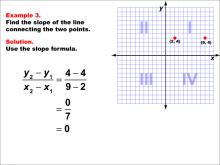
|
Math Example--Coordinate Geometry--Slope Formula: Example 3 | Math Example--Coordinate Geometry--Slope Formula: Example 3TopicSlope Formula DescriptionThis example demonstrates the calculation of slope for a horizontal line connecting points (2, 4) and (9, 4) on a coordinate grid. When we apply the slope formula, we find that the slope is (4 - 4) / (9 - 2) = 0 / 7 = 0. The slope formula is a fundamental concept in coordinate geometry, helping us understand the steepness and direction of lines. This particular example highlights a special case where the line is horizontal, resulting in a slope of zero. |
Slope |

|
Math Example--Coordinate Geometry--Slope Formula: Example 3 | Math Example--Coordinate Geometry--Slope Formula: Example 3TopicSlope Formula DescriptionThis example demonstrates the calculation of slope for a horizontal line connecting points (2, 4) and (9, 4) on a coordinate grid. When we apply the slope formula, we find that the slope is (4 - 4) / (9 - 2) = 0 / 7 = 0. The slope formula is a fundamental concept in coordinate geometry, helping us understand the steepness and direction of lines. This particular example highlights a special case where the line is horizontal, resulting in a slope of zero. |
Slope |
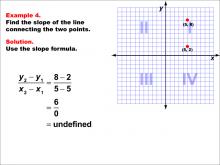
|
Math Example--Coordinate Geometry--Slope Formula: Example 4 | Math Example--Coordinate Geometry--Slope Formula: Example 4TopicSlope Formula DescriptionThis example illustrates the calculation of slope for a vertical line passing through points (5, 8) and (5, 2) on a coordinate grid. When we apply the slope formula, we find that the slope is (8 - 2) / (5 - 5) = 6 / 0, which is undefined. The slope formula is a key concept in coordinate geometry, helping us understand the steepness and direction of lines. This particular example highlights a special case where the line is vertical, resulting in an undefined slope. |
Slope |

|
Math Example--Coordinate Geometry--Slope Formula: Example 4 | Math Example--Coordinate Geometry--Slope Formula: Example 4TopicSlope Formula DescriptionThis example illustrates the calculation of slope for a vertical line passing through points (5, 8) and (5, 2) on a coordinate grid. When we apply the slope formula, we find that the slope is (8 - 2) / (5 - 5) = 6 / 0, which is undefined. The slope formula is a key concept in coordinate geometry, helping us understand the steepness and direction of lines. This particular example highlights a special case where the line is vertical, resulting in an undefined slope. |
Slope |
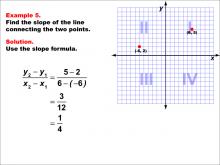
|
Math Example--Coordinate Geometry--Slope Formula: Example 5 | Math Example--Coordinate Geometry--Slope Formula: Example 5TopicSlope Formula DescriptionThis example demonstrates the calculation of slope for a line connecting two points in different quadrants: (-6, -2) in Quadrant III and (6, 5) in Quadrant I. Applying the slope formula, we find that the slope is (5 - (-2)) / (6 - (-6)) = 7 / 12 = 1 / 4. The slope formula is a crucial concept in coordinate geometry, helping us understand the steepness and direction of lines. This example shows how to handle negative coordinates and points in different quadrants when calculating slope. |
Slope |

|
Math Example--Coordinate Geometry--Slope Formula: Example 5 | Math Example--Coordinate Geometry--Slope Formula: Example 5TopicSlope Formula DescriptionThis example demonstrates the calculation of slope for a line connecting two points in different quadrants: (-6, -2) in Quadrant III and (6, 5) in Quadrant I. Applying the slope formula, we find that the slope is (5 - (-2)) / (6 - (-6)) = 7 / 12 = 1 / 4. The slope formula is a crucial concept in coordinate geometry, helping us understand the steepness and direction of lines. This example shows how to handle negative coordinates and points in different quadrants when calculating slope. |
Slope |
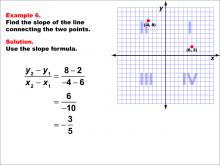
|
Math Example--Coordinate Geometry--Slope Formula: Example 6 | Math Example--Coordinate Geometry--Slope Formula: Example 6TopicSlope Formula DescriptionThis example illustrates the calculation of slope for a line connecting two points in different quadrants: (-4, 8) in Quadrant II and (6, 2) in Quadrant I. Applying the slope formula, we find that the slope is (8 - 2) / (-4 - 6) = 6 / -10 = -3 / 5. The slope formula is a fundamental concept in coordinate geometry, helping us understand the steepness and direction of lines. This example demonstrates how to handle points in different quadrants and interpret a negative slope. |
Slope |

|
Math Example--Coordinate Geometry--Slope Formula: Example 6 | Math Example--Coordinate Geometry--Slope Formula: Example 6TopicSlope Formula DescriptionThis example illustrates the calculation of slope for a line connecting two points in different quadrants: (-4, 8) in Quadrant II and (6, 2) in Quadrant I. Applying the slope formula, we find that the slope is (8 - 2) / (-4 - 6) = 6 / -10 = -3 / 5. The slope formula is a fundamental concept in coordinate geometry, helping us understand the steepness and direction of lines. This example demonstrates how to handle points in different quadrants and interpret a negative slope. |
Slope |
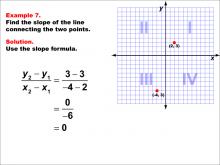
|
Math Example--Coordinate Geometry--Slope Formula: Example 7 | Math Example--Coordinate Geometry--Slope Formula: Example 7TopicSlope Formula DescriptionThis example demonstrates the calculation of slope for a horizontal line connecting two points: (-4, 3) in Quadrant II and (2, 3) in Quadrant I. When we apply the slope formula, we find that the slope is (3 - 3) / (-4 - 2) = 0 / -6 = 0. The slope formula is a key concept in coordinate geometry, helping us understand the steepness and direction of lines. This particular example highlights a special case where the line is horizontal, resulting in a slope of zero, even when the points are in different quadrants. |
Slope |

|
Math Example--Coordinate Geometry--Slope Formula: Example 7 | Math Example--Coordinate Geometry--Slope Formula: Example 7TopicSlope Formula DescriptionThis example demonstrates the calculation of slope for a horizontal line connecting two points: (-4, 3) in Quadrant II and (2, 3) in Quadrant I. When we apply the slope formula, we find that the slope is (3 - 3) / (-4 - 2) = 0 / -6 = 0. The slope formula is a key concept in coordinate geometry, helping us understand the steepness and direction of lines. This particular example highlights a special case where the line is horizontal, resulting in a slope of zero, even when the points are in different quadrants. |
Slope |
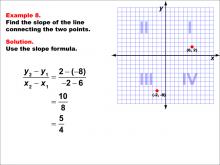
|
Math Example--Coordinate Geometry--Slope Formula: Example 8 | Math Example--Coordinate Geometry--Slope Formula: Example 8TopicSlope Formula DescriptionThis example illustrates the calculation of slope for a line connecting two points in different quadrants: (-2, -8) in Quadrant III and (6, 2) in Quadrant I. Applying the slope formula, we find that the slope is (2 - (-8)) / (6 - (-2)) = 10 / 8 = 5 / 4. The slope formula is a crucial concept in coordinate geometry, helping us understand the steepness and direction of lines. This example shows how to handle negative coordinates and points in different quadrants when calculating slope. |
Slope |

|
Math Example--Coordinate Geometry--Slope Formula: Example 8 | Math Example--Coordinate Geometry--Slope Formula: Example 8TopicSlope Formula DescriptionThis example illustrates the calculation of slope for a line connecting two points in different quadrants: (-2, -8) in Quadrant III and (6, 2) in Quadrant I. Applying the slope formula, we find that the slope is (2 - (-8)) / (6 - (-2)) = 10 / 8 = 5 / 4. The slope formula is a crucial concept in coordinate geometry, helping us understand the steepness and direction of lines. This example shows how to handle negative coordinates and points in different quadrants when calculating slope. |
Slope |
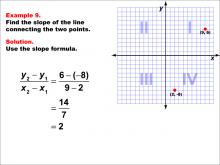
|
Math Example--Coordinate Geometry--Slope Formula: Example 9 | Math Example--Coordinate Geometry--Slope Formula: Example 9TopicSlope Formula DescriptionThis example demonstrates the calculation of slope for a line connecting two points: (9, 6) and (2, -8) on a Cartesian plane. Applying the slope formula, we find that the slope is (6 - (-8)) / (9 - 2) = 14 / 7 = 2. The slope formula is a fundamental concept in coordinate geometry, helping us understand the steepness and direction of lines. This example shows how to handle points with both positive and negative coordinates when calculating slope. |
Slope |

|
Math Example--Coordinate Geometry--Slope Formula: Example 9 | Math Example--Coordinate Geometry--Slope Formula: Example 9TopicSlope Formula DescriptionThis example demonstrates the calculation of slope for a line connecting two points: (9, 6) and (2, -8) on a Cartesian plane. Applying the slope formula, we find that the slope is (6 - (-8)) / (9 - 2) = 14 / 7 = 2. The slope formula is a fundamental concept in coordinate geometry, helping us understand the steepness and direction of lines. This example shows how to handle points with both positive and negative coordinates when calculating slope. |
Slope |
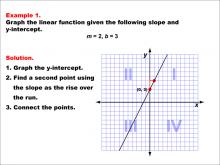
|
Math Example--Linear Function Concepts--Graphs of Linear Functions in Slope-Intercept Form: Example 1 | Math Example--Linear Function Concepts--Graphs of Linear Functions in Slope-Intercept Form: Example 1TopicLinear Functions DescriptionThis example demonstrates how to graph a linear function with a slope of 2 and a y-intercept of 3. The process involves three key steps: first, plotting the y-intercept at (0, 3); second, using the slope to find another point on the line; and finally, connecting these points to form the line. |
Slope-Intercept Form |